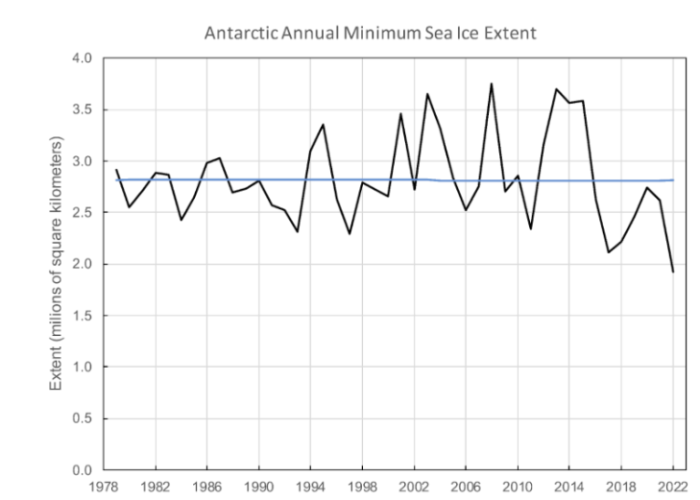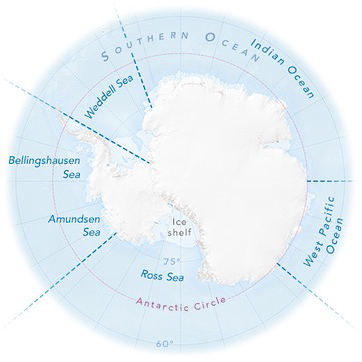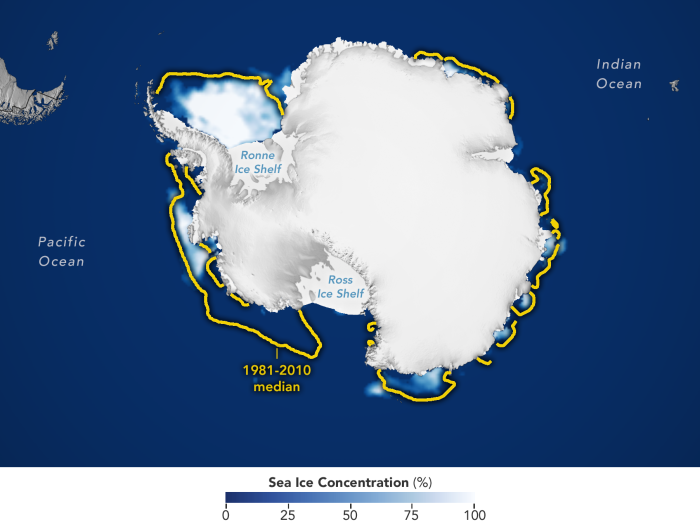- Record low values of sea ice extent in Antarctic in 2022
- Implications for local marine life, the food chain and ice sheet melt.

Antarctic sea ice affects global climate by reflecting sunlight, influencing air-sea interactions and ocean circulation. Sea ice also provides habitat for krill, a keystone species in the Southern Ocean food web.

Despite global warming, Antarctic sea ice coverage slowly increased from 1979 until the mid-2010s. Then, in 2016, an unprecedented decline in sea ice occurred during spring, leading to sustained record low sea ice coverage. Since then, sea ice had somewhat rebounded.
However, in spring 2021 sea ice once again decreased rapidly, with total coverage at its third-lowest level for spring.

Continued rapid loss has led to record low extent in late summer 2021-22, the first time that the ice was observed to shrink below 2 million square kilometres. This was followed by a series of much below-average extents observed since February 2022, including record low values for the time of year in June and July 2022. This led to a new record low in summer 2022-23, when sea ice reached its lowest extent ever observed since the start of the satellite record in 1979.
These extreme sea ice events represent an increase in Antarctic sea ice variability which has been linked to changes in the balance of sea ice trends across different Antarctic regions: the relative decrease of the role of the Amundsen-Bellingshausen region and increased role of the Weddell region for total Antarctic Sea ice.

The ARC Centre of Excellence for Climate Extremes is continuing to research and understand the drivers of these sea ice extreme events and sea ice predictability. Whether the changes in Antarctic sea ice variability over the past decade are due to multidecadal variability (natural climate cycles) or a response to climate change is yet to be established. However, recent work shows that warming in the Amundsen-Bellingshausen region is unequivocally due to anthropogenic greenhouse gasses.
Main Research Contact: Professor Julie Arblaster | julie.arblaster@monash.edu Dr Amelie Meyer | amelie.meyer@utas.edu.au
The State of Weather and Climate Extremes 2022
Weather and climate extremes in Antarctica
Extreme events in 2022
Heatwaves in Western Australia
Extreme rainfall and flooding in Queensland and New South Wales February-March 2022
Record low Antarctic sea ice extent in 2022
Simultaneous Antarctic and Arctic heatwaves
Collapse of East Antarctic Conger ice shelf
Hailstorms in Queensland, Victoria and New South Wales
Damaging wind gusts in South Australia and the Northern Territory
© 2023 ARC Centre of Excellence for Climate Extremes
References and acknowledgements available in the PDF version available here.
Materials used are for educational purposes and either author provided or used under fair dealing provisions.
